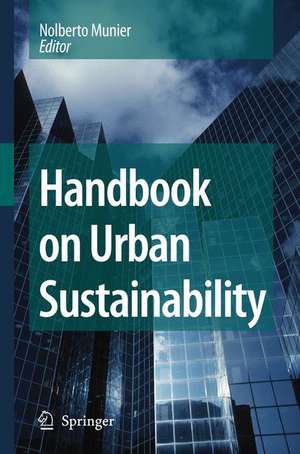Handbook on Urban Sustainability
Editat de Nolberto Munieren Limba Engleză Hardback – 5 dec 2006
| Toate formatele și edițiile | Preț | Express |
|---|---|---|
| Paperback (1) | 1841.23 lei 6-8 săpt. | |
| SPRINGER NETHERLANDS – 23 aug 2016 | 1841.23 lei 6-8 săpt. | |
| Hardback (1) | 1852.57 lei 6-8 săpt. | |
| SPRINGER NETHERLANDS – 5 dec 2006 | 1852.57 lei 6-8 săpt. |
Preț: 1852.57 lei
Preț vechi: 2259.23 lei
-18% Nou
Puncte Express: 2779
Preț estimativ în valută:
354.58€ • 368.78$ • 297.14£
354.58€ • 368.78$ • 297.14£
Carte tipărită la comandă
Livrare economică 13-27 martie
Preluare comenzi: 021 569.72.76
Specificații
ISBN-13: 9781402053504
ISBN-10: 1402053509
Pagini: 804
Ilustrații: XXVII, 804 p.
Dimensiuni: 155 x 235 x 41 mm
Greutate: 1.47 kg
Ediția:2007
Editura: SPRINGER NETHERLANDS
Colecția Springer
Locul publicării:Dordrecht, Netherlands
ISBN-10: 1402053509
Pagini: 804
Ilustrații: XXVII, 804 p.
Dimensiuni: 155 x 235 x 41 mm
Greutate: 1.47 kg
Ediția:2007
Editura: SPRINGER NETHERLANDS
Colecția Springer
Locul publicării:Dordrecht, Netherlands
Public țintă
ResearchCuprins
Characteristics and Analysis of Urban Sustainable Systems.- Urban Social Sustainability.- The City and Its Environment.- Economy of the City and its Region.- Improving Lives of Slum Dwellers: Challenges and Strategies.- Planning for Sustainable Urban Environments.- Towards Sustainable Municipal infrastructure Asset Management.- Urban Energy Management.- Urban Transportation Management.- Energy Use and Urban Buildings.- An Example of Creation of Self-Managed Cities.- Urban Wastes Management.- Water in the Urban Environment.- Natural Risk Assessment and Management.- Urban Reconstruction.- Road Map to Urban Sustainability and Decision-Making.- Process for Implementing a Municipal Sustainability Plan.
Recenzii
"This volume belongs in the library of every serious city planner and policy-maker committed to building a future that works for us all." Mathis Wackernagel, Global Footprint Network
Textul de pe ultima copertă
Municipal authorities and agencies around the world are striving to place their cities on the road to sustainability. Cities, as very complex entities, offer a constant interaction between people, resources and the environment. This makes strategic planning demanding and difficult.
This book, written by worldwide specialists from Canada, India, Italy, Palestine, Peru, Spain and the Netherlands, is a guide to establishing a city on a sustainable path. It addresses sustainable urban planning issues by breaking the city down to its main components. The authors analyze and discuss such topics as:
"This volume belongs in the library of every serious city planner and policy-maker committed to building a future that works for us all."
Mathis Wackernagel, Global Footprint Network
This book, written by worldwide specialists from Canada, India, Italy, Palestine, Peru, Spain and the Netherlands, is a guide to establishing a city on a sustainable path. It addresses sustainable urban planning issues by breaking the city down to its main components. The authors analyze and discuss such topics as:
- urban social and economic factors, including immigration and cultural integration, the gender component, the formation of slums, and social indicators
- the interaction of the city with the environment, including the Environmental Impact Assessment (EIA)
- urban and regional economics, including specialization and dependency, asset management, and community facilities
- the relationship of a city within its region
- urban planning, including urban sprawl and core revitalization
- housing and relocation, including such concepts as community participation
- degradation and measures to reverse this situation
- energy needs, transportation management, basic infrastructural services, the generation and disposal of waste, and water in the region
- a city’s preparedness, including risk analysis and contingency plans
- urban reconstruction after disasters
"This volume belongs in the library of every serious city planner and policy-maker committed to building a future that works for us all."
Mathis Wackernagel, Global Footprint Network
Caracteristici
Takes the reader from grass-roots level to completion of an urban sustainability plan Provides comprehensive knowledge of urban sustainability issues Provides detailed case studies Contributors from around the world Of international interest
















